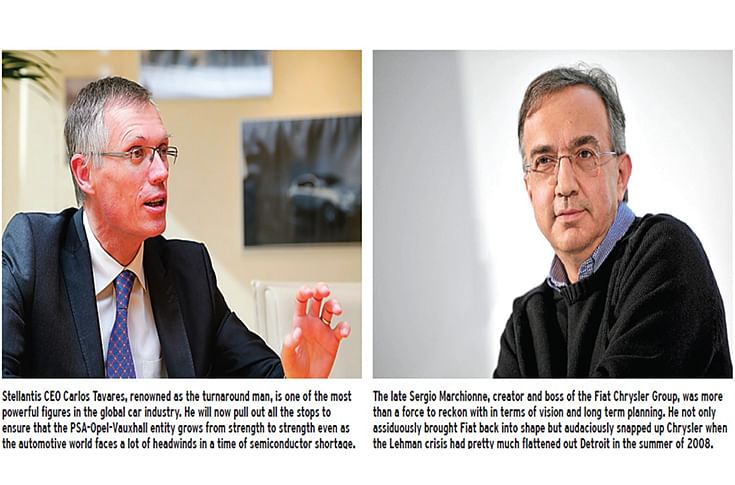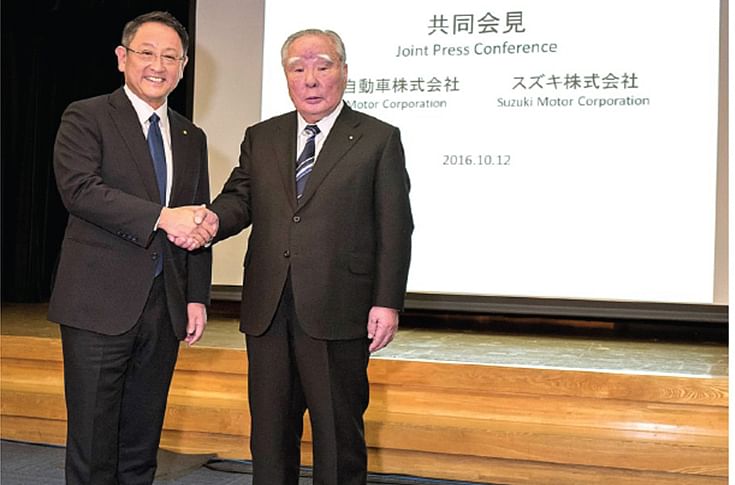Leading from the front
As Stellantis begins its new journey, there is a sense of assurance about Carlos Tavares being at the helm of affairs. Effective leadership has made the difference in today’s competitive times.
With Stellantis kicking off its new chapter in the competitive India market, Roland Bouchara will have his task cut out in getting the teams from Citroen and Fiat Chrysler Automobiles (FCA) to work more closely together. It will be quite a challenging task since individuals have their own egos and temperaments but there is really no way out going forward.
After all, partnerships and collaborations are now inevitable in the automotive arena as companies gear up for a challenging decade of mobility disruptions. This is where it makes sense to have an ally who can share investments and competencies for new forays like electric. For this to happen without any hiccups, good leadership is an imperative.
Carlos Ghosn: Once a poster boy
Carlos Ghosn could be leading the life of a fugitive in his native Lebanon but the former Chairman of Renault-Nissan was in a league of his own when the going was good and he strode the global automotive stage like a colossus. The company he rescued two decades earlier ended up putting him in jail but there is no question that his leadership skills played a huge role in reviving a beleaguered Nissan when it was down and out.
It was Ghosn who spearheaded the Renault revival plan for Nissan way back in 1999 and the turnaround was so effective that he was regarded as a virtual superman in Japan to the extent that Manga comics also featured him. Today, he could be accused of many misdemeanours but during his heyday Ghosn was the undisputed poster boy of the automobile industry. Today, his critics speak of his autocratic style of functioning but it is debatable if the Renault-Nissan alliance would have survived had he not been at the helm to handle the turnaround story for the Japanese ally. After all, the months following his arrest were the most difficult for the alliance with the partners not on the best of terms with each other and losses continued to pile up.
Today, things are a lot better with a new leadership structure in place both at Renault and Nissan but the interim journey was anything but a smooth drive. There is also little doubt that had Ghosn not been arrested on that dramatic day of November 2018, FCA couldwell have been within the Renault-Nissan fold which also includes Mitsubishi, another coup by Ghosn when a lifeline was thrown to the struggling Japanese automaker.

Carlos Tavares: Auto Inc's heavyweight champion
Today, as Ghosn leads a quieter life in Beirut away from all the glamour and fame, it is the other Carlos — Tavares in this case — who has emerged one of the most formidable leaders in the global automotive arena. The Chairman of Groupe PSA wasted little time in sewing up a merger with FCA which has now spawned the new entity, Stellantis.
Tavares was at the forefront of this exercise and talks moved at a rapid pace with FCA which had actually reached out to Renault first for a merger proposal in the months following Ghosn’s arrest The offer was withdrawn in less than a fortnight and Groupe PSA was quick to capitalise on the opportunity with Tavares clearly the brains behind the merger. As CEO of Stellantis, he is keen on taking the game to the next level even as the challenges are immense.
Yet, industry observers believe that he has the vision and determination to make this merger a success story given what he had achieved after taking over as Chairman of Groupe PSA. The French automaker was in big trouble during the time following the global slowdown of 2009 and it required a lifeline from Dongfeng Motors of China to keep it afloat.
Thereafter, Tavares worked on a massive cost restructuring exercise which saw PSA emerge a lot stronger and then go the extra mile by buying out Opel and Vauxhall from General Motors. The Stellantis CEO will now pull out all the stops to ensure that the entity grows from strength to strength even as the automotive world faces a lot of headwinds arising from emission regulations, geopolitical tensions, uncertainty on the energy scenario, shortage of semiconductors and so on.
Sergio Marchionne: Fiat’s titan
It is now three years since Sergio Marchionne passed away but during his tenure as the CEO of FCA, he was more than a force to reckon with in terms of vision and long term planning. When Marchionne first took over as the head of the then solo Fiat, the Italian automaker was not in the best of shape. Marchionne put the house in order and then audaciously snapped up Chrysler when the Lehman crisis had pretty much flattened out Detroit in the summer of 2008. It was a bold move that has since yielded big returns for FCA, thanks to the Jeep brand which now accounts for a third of total global sales and is making speedy moves at electrification.
Marchionne then reached out to GM for a merger proposal but the latter was not interested though there is no taking away the fact that he understood the need for further consolidation within the auto industry. Had he been alive today, it would have been interesting to see how Marchionne and Tavares jointly navigated the Stellantis story.

Akio Toyoda and Osamu Suzuki: Legendary leaders
If there is another top leader who continues to make the news, it is Akio Toyoda, President of Toyota Motor Corporation. He has not only redefined the mobility priorities of his company but is quickly sewing up alliances within Japan Inc. The first big one was with Suzuki Motor Corporation which is a well known name in India thanks to the huge success story of Maruti.
Osamu Suzuki, the formidable chief of the company, had had his share of alliances before coming on board with Toyota. Decades earlier, Suzuki was in a partnership e with GM during the glorious days of Detroit ruling the roost. The partners were quite happy together but the contours changed when GM bought out Daewoo and Suzuki gradually went on its own before opting for an alliance with Volkswagen. Even though it looked promising, the two just did not see eye to eye and a bitter divorce followed in a few years.
When Akio Toyoda and Osamu Suzuki first announced their intent to join hands, it was a strong statement of intent from Japan Inc on the need for consolidation. Both companies respect each other’s competencies, which will come in handy during this challenging decade. Toyota has the technological strengths while Suzuki is the master of costing efficiencies as evident in its India success story.
It will be interesting to see how the partnership pans out in the coming years beyond the current scenario of product swaps. Going forward, the Toyota-Suzuki combine will play a big role jointly in areas like EVs, hybrids and safety. Toyota also has an alliance with Mazda for North America and subsidiary, Daihatsu, for the ASEAN region. More recently, the company has kicked off an electrification initiative with Japanese truck makers, Isuzu and Hino, in Japan where Suzuki and Daihatsu are now the recent car entrants to this consortium. Akio Toyoda is working on a plan which will see his company leverage its own strengths as well as those of its allies to take on new challenges.
Some of these remarkable individuals featured in this narrative have shown what it takes when it comes to effective leadership. It is not as if they would not have their share of detractors but by the end of the day, there is nothing as sweet as success to bolster the brand image of an individual. Hence, even while the halo once surrounding Carlos Ghosn has vastly diminished, even his worst critics will admit that his role was critical to steer the Renault-Nissan alliance.
Effective leadership is also important at a time when the industry is facing a host of new challenges on emissions, investments in electrification, coping with the realities of climate change and geopolitical tensions. It is in this backdrop where mettle is truly tested and will separate the men from theboys.
For instance, there is an increased sense of wariness about China despite the fact that it is the world’s largest market for automobiles and is also a key pivot of the global supply chain. Chinese OEMs are also keen on establishing themselves as strong brands which can spin their own success stories as seen in the Geely acquisition of Volvo Cars.
The company has since bought out stakes in Volvo Trucks and Daimler AG. It is this reality of being bought over that has perhaps compelled car brands to join hands with each other or for countries like Japan to go in for further consolidation with Toyota leading the way. It is well known by now that there was a time when Great Wall Motors was eyeing the Jeep brand except that nothing came out of this eventually. As China grows from strength to strength, global CEOs will have to strike the balance between tapping business opportunities and keeping the interests of their own companies intact.
On the subject of partnerships, the Volkswagen Group went in for a recast exercise which now has Skoda lead managing the show in India as part of a new initiative to make cost-competitive cars and SUVs. Both Volkswagen and Skoda brands will be produced on common platforms which goes on to show that two heads are better than one in these difficult times.
Likewise, on the two-wheeler side, long-time foes Honda and Yamaha have also come together to produce a niche segment of sub-50cc scooters for Japan. Observers believe this is only the beginning of a bigger story which will see both companies pooling in their strengths for areas like electric.
One would have never thought some years ago that Honda and Yamaha would actually end up burying the hatchet after their bitter rivalries termed the H-Y war but in today’s competitive era, it perhaps makes more sense to shake hands and make up. The fact that Japan’s auto industry is quickly consolidating itself can also be borne out by the reality of the quartet of Honda, Yamaha, Suzuki and Kawasaki coming together for a battery consortium. Two heads — or in the case four — are finally better than one!
This feature was first published in Autocar Professional's October 15 issue.
RELATED ARTICLES
Ashok Leyland's Mix of Strategy and Sustainability Ashok Leyland Aligns Sustainability Goals With Business Operations
Ashok Leyland is embedding sustainability deep into its operational strategy, leveraging green finance, electrification,...
New Players Reshape India’s Electric CV Ecosystem The Evolution of India’s e-CV Landscape
Unlike in cars and two-wheelers, the electrification of commercial vehicles is in very early stages due to uncertainty o...
Auto Giants Explore Hybrid Strategy as EVs Hit Speed Bumps
Slower-than-expected EV adoption, tight CAFE norms and ever-present efficiency demands are giving hybrids a second wind ...





 16 Oct 2021
16 Oct 2021
 6697 Views
6697 Views





 Shahkar Abidi
Shahkar Abidi



 Ketan Thakkar
Ketan Thakkar

